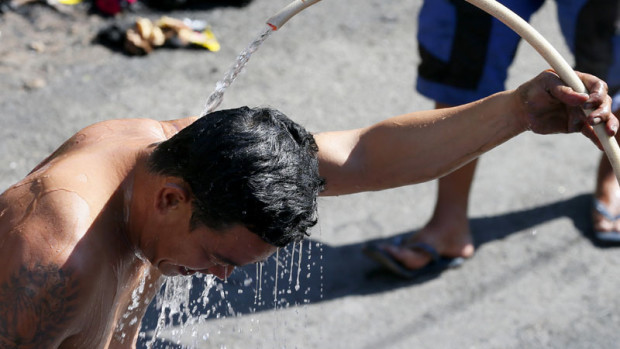Pagasa: Metro Manila, 15 other areas to have ‘danger-level’ heat index

FILE PHOTO: Stay indoors and hydrate, according to Pagasa, as heat index reached “danger” level in several areas of the country on Wednesday, May 1, 2019. AP Photo/Bullit Marquez
MANILA, Philippines — Metro Manila and 15 other areas nationwide are seen on Maundy Thursday to have “dangerous” heat index, according to the state weather bureau.
The southern section of the National Capital Region (NCR) is seen to experience a 42-degree Celsius heat index, according to the Philippine Atmospheric, Geophysical and Astronomical Services Administration’s (Pagasa) weather station in Pasay City.
READ: Hot, humid weather in Metro Manila, most of PH on Maundy Thursday
Meanwhile, according to Pagasa’s weather station in Quezon City, a heat index of 43 degrees Celsius is also expected in the northern portion of NCR.
Here are the forecast heat index of other areas under the “danger” category as reported by Pagasa’s weather stations:
- Iba, Zambales: 43 degrees Celsius
- Clark, Pampanga: 42 degrees Celsius
- Subic, Zambales: 43 degrees Celsius
- Sangley Point, Cavite: 44 degrees Celsius
- Tanauan, Batangas: 42 degrees Celsius
- Mulanay, Quezon: 42 degrees Celsius
- Coron, Palawan: 43 degrees Celsius
- San Jose, Occidental Mindoro: 43 degrees Celsius
- Puerto Princesa City: 45 degrees Celsius
- Aborlan, Palawan: 45 degrees Celsius
- Pili, Camarines Sur: 44 degrees Celsius
- Roxas City, Capiz: 45 degrees Celsius
- Mambusao, Capiz: 42 degrees Celsius
- Iloilo City, Iloilo: 44 degrees Celsius
- Dumangas, Iloilo: 43 degrees Celsius
The heat index, which ranges from 42 degrees Celsius to 51 degrees Celsius, is in the “danger” category. It could likely cause heat cramps and exhaustion, while heat stroke is probable with continued exposure to the sun.

The danger category is just before “extreme danger,” which is the highest category of heat index level, referring to temperatures of 52 degrees Celsius and beyond. Meanwhile, “extreme caution” ranges from 33–41 degrees Celsius, and “caution” is 27–32 degrees Celsius.
Heat index measures the level of discomfort an average person experiences due to the combined effects of temperature and air humidity.
On March 23, Pagasa also officially declared the start of the summer season, marking the end of the prevailing northeast monsoon, or amihan, which brought colder temperatures nationwide.
Also, Pagasa said El Niño still prevails nationwide, causing below-normal rainfall conditions that could bring “dry spells” or droughts in some parts of the country until the first quarter of 2024.